Bo Wang
Tencent, WeChat Pay
Multi-hop Reasoning via Early Knowledge Alignment
Dec 23, 2025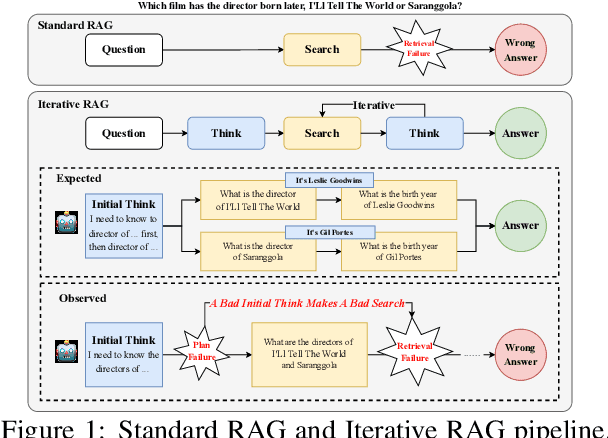


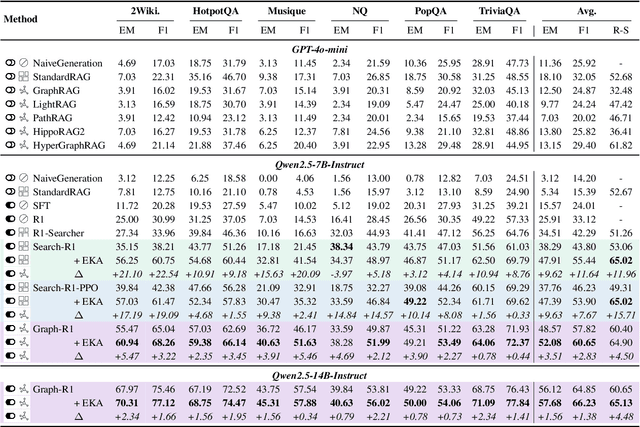
Abstract:Retrieval-Augmented Generation (RAG) has emerged as a powerful paradigm for Large Language Models (LLMs) to address knowledge-intensive queries requiring domain-specific or up-to-date information. To handle complex multi-hop questions that are challenging for single-step retrieval, iterative RAG approaches incorporating reinforcement learning have been proposed. However, existing iterative RAG systems typically plan to decompose questions without leveraging information about the available retrieval corpus, leading to inefficient retrieval and reasoning chains that cascade into suboptimal performance. In this paper, we introduce Early Knowledge Alignment (EKA), a simple but effective module that aligns LLMs with retrieval set before planning in iterative RAG systems with contextually relevant retrieved knowledge. Extensive experiments on six standard RAG datasets demonstrate that by establishing a stronger reasoning foundation, EKA significantly improves retrieval precision, reduces cascading errors, and enhances both performance and efficiency. Our analysis from an entropy perspective demonstrate that incorporating early knowledge reduces unnecessary exploration during the reasoning process, enabling the model to focus more effectively on relevant information subsets. Moreover, EKA proves effective as a versatile, training-free inference strategy that scales seamlessly to large models. Generalization tests across diverse datasets and retrieval corpora confirm the robustness of our approach. Overall, EKA advances the state-of-the-art in iterative RAG systems while illuminating the critical interplay between structured reasoning and efficient exploration in reinforcement learning-augmented frameworks. The code is released at \href{https://github.com/yxzwang/EarlyKnowledgeAlignment}{Github}.
Grad: Guided Relation Diffusion Generation for Graph Augmentation in Graph Fraud Detection
Dec 19, 2025Abstract:Nowadays, Graph Fraud Detection (GFD) in financial scenarios has become an urgent research topic to protect online payment security. However, as organized crime groups are becoming more professional in real-world scenarios, fraudsters are employing more sophisticated camouflage strategies. Specifically, fraudsters disguise themselves by mimicking the behavioral data collected by platforms, ensuring that their key characteristics are consistent with those of benign users to a high degree, which we call Adaptive Camouflage. Consequently, this narrows the differences in behavioral traits between them and benign users within the platform's database, thereby making current GFD models lose efficiency. To address this problem, we propose a relation diffusion-based graph augmentation model Grad. In detail, Grad leverages a supervised graph contrastive learning module to enhance the fraud-benign difference and employs a guided relation diffusion generator to generate auxiliary homophilic relations from scratch. Based on these, weak fraudulent signals would be enhanced during the aggregation process, thus being obvious enough to be captured. Extensive experiments have been conducted on two real-world datasets provided by WeChat Pay, one of the largest online payment platforms with billions of users, and three public datasets. The results show that our proposed model Grad outperforms SOTA methods in both various scenarios, achieving at most 11.10% and 43.95% increases in AUC and AP, respectively. Our code is released at https://github.com/AI4Risk/antifraud and https://github.com/Muyiiiii/WWW25-Grad.
* Accepted by The Web Conference 2025 (WWW'25). 12 pages, includes implementation details. Code: https://github.com/AI4Risk/antifraud and https://github.com/Muyiiiiii/WWW25-Grad
TF-MCL: Time-frequency Fusion and Multi-domain Cross-Loss for Self-supervised Depression Detection
Dec 14, 2025Abstract:In recent years, there has been a notable increase in the use of supervised detection methods of major depressive disorder (MDD) based on electroencephalogram (EEG) signals. However, the process of labeling MDD remains challenging. As a self-supervised learning method, contrastive learning could address the shortcomings of supervised learning methods, which are unduly reliant on labels in the context of MDD detection. However, existing contrastive learning methods are not specifically designed to characterize the time-frequency distribution of EEG signals, and their capacity to acquire low-semantic data representations is still inadequate for MDD detection tasks. To address the problem of contrastive learning method, we propose a time-frequency fusion and multi-domain cross-loss (TF-MCL) model for MDD detection. TF-MCL generates time-frequency hybrid representations through the use of a fusion mapping head (FMH), which efficiently remaps time-frequency domain information to the fusion domain, and thus can effectively enhance the model's capacity to synthesize time-frequency information. Moreover, by optimizing the multi-domain cross-loss function, the distribution of the representations in the time-frequency domain and the fusion domain is reconstructed, thereby improving the model's capacity to acquire fusion representations. We evaluated the performance of our model on the publicly available datasets MODMA and PRED+CT and show a significant improvement in accuracy, outperforming the existing state-of-the-art (SOTA) method by 5.87% and 9.96%, respectively.
A 96pJ/Frame/Pixel and 61pJ/Event Anti-UAV System with Hybrid Object Tracking Modes
Dec 12, 2025Abstract:We present an energy-efficient anti-UAV system that integrates frame-based and event-driven object tracking to enable reliable detection of small and fast-moving drones. The system reconstructs binary event frames using run-length encoding, generates region proposals, and adaptively switches between frame mode and event mode based on object size and velocity. A Fast Object Tracking Unit improves robustness for high-speed targets through adaptive thresholding and trajectory-based classification. The neural processing unit supports both grayscale-patch and trajectory inference with a custom instruction set and a zero-skipping MAC architecture, reducing redundant neural computations by more than 97 percent. Implemented in 40 nm CMOS technology, the 2 mm^2 chip achieves 96 pJ per frame per pixel and 61 pJ per event at 0.8 V, and reaches 98.2 percent recognition accuracy on public UAV datasets across 50 to 400 m ranges and 5 to 80 pixels per second speeds. The results demonstrate state-of-the-art end-to-end energy efficiency for anti-UAV systems.
IMAGINE: Integrating Multi-Agent System into One Model for Complex Reasoning and Planning
Oct 16, 2025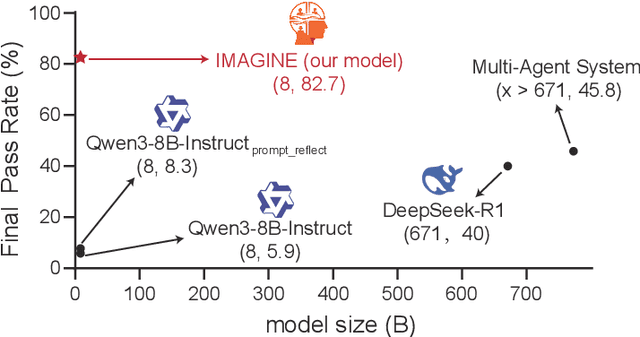
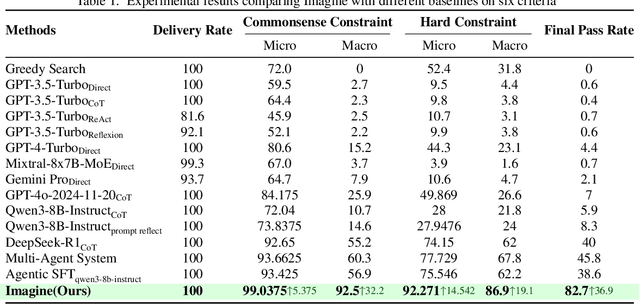

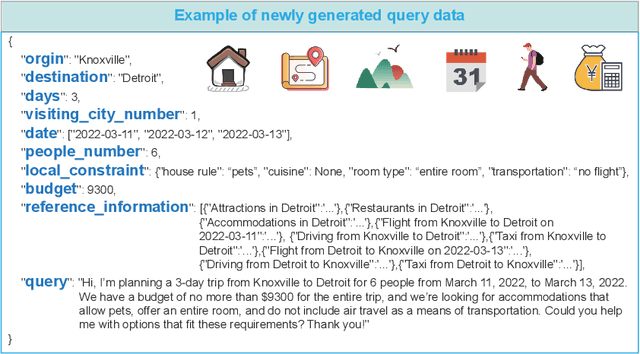
Abstract:Although large language models (LLMs) have made significant strides across various tasks, they still face significant challenges in complex reasoning and planning. For example, even with carefully designed prompts and prior information explicitly provided, GPT-4o achieves only a 7% Final Pass Rate on the TravelPlanner dataset in the sole-planning mode. Similarly, even in the thinking mode, Qwen3-8B-Instruct and DeepSeek-R1-671B, only achieve Final Pass Rates of 5.9% and 40%, respectively. Although well-organized Multi-Agent Systems (MAS) can offer improved collective reasoning, they often suffer from high reasoning costs due to multi-round internal interactions, long per-response latency, and difficulties in end-to-end training. To address these challenges, we propose a general and scalable framework called IMAGINE, short for Integrating Multi-Agent System into One Model. This framework not only integrates the reasoning and planning capabilities of MAS into a single, compact model, but also significantly surpass the capabilities of the MAS through a simple end-to-end training. Through this pipeline, a single small-scale model is not only able to acquire the structured reasoning and planning capabilities of a well-organized MAS but can also significantly outperform it. Experimental results demonstrate that, when using Qwen3-8B-Instruct as the base model and training it with our method, the model achieves an 82.7% Final Pass Rate on the TravelPlanner benchmark, far exceeding the 40% of DeepSeek-R1-671B, while maintaining a much smaller model size.
Role-Aware Multi-modal federated learning system for detecting phishing webpages
Sep 26, 2025Abstract:We present a federated, multi-modal phishing website detector that supports URL, HTML, and IMAGE inputs without binding clients to a fixed modality at inference: any client can invoke any modality head trained elsewhere. Methodologically, we propose role-aware bucket aggregation on top of FedProx, inspired by Mixture-of-Experts and FedMM. We drop learnable routing and use hard gating (selecting the IMAGE/HTML/URL expert by sample modality), enabling separate aggregation of modality-specific parameters to isolate cross-embedding conflicts and stabilize convergence. On TR-OP, the Fusion head reaches Acc 97.5% with FPR 2.4% across two data types; on the image subset (ablation) it attains Acc 95.5% with FPR 5.9%. For text, we use GraphCodeBERT for URLs and an early three-way embedding for raw, noisy HTML. On WebPhish (HTML) we obtain Acc 96.5% / FPR 1.8%; on TR-OP (raw HTML) we obtain Acc 95.1% / FPR 4.6%. Results indicate that bucket aggregation with hard-gated experts enables stable federated training under strict privacy, while improving the usability and flexibility of multi-modal phishing detection.
Rethinking Human-Object Interaction Evaluation for both Vision-Language Models and HOI-Specific Methods
Aug 26, 2025Abstract:Prior human-object interaction (HOI) detection methods have integrated early vision-language models (VLMs) such as CLIP, but only as supporting components within their frameworks. In contrast, recent advances in large, generative VLMs suggest that these models may already possess strong ability to understand images involving HOI. This naturally raises an important question: can general-purpose standalone VLMs effectively solve HOI detection, and how do they compare with specialized HOI methods? Answering this requires a benchmark that can accommodate both paradigms. However, existing HOI benchmarks such as HICO-DET were developed before the emergence of modern VLMs, and their evaluation protocols require exact matches to annotated HOI classes. This is poorly aligned with the generative nature of VLMs, which often yield multiple valid interpretations in ambiguous cases. For example, a static image may capture a person mid-motion with a frisbee, which can plausibly be interpreted as either "throwing" or "catching". When only "catching" is annotated, the other, though equally plausible for the image, is marked incorrect when exact matching is used. As a result, correct predictions might be penalized, affecting both VLMs and HOI-specific methods. To avoid penalizing valid predictions, we introduce a new benchmark that reformulates HOI detection as a multiple-answer multiple-choice task, where each question includes only ground-truth positive options and a curated set of negatives that are constructed to reduce ambiguity (e.g., when "catching" is annotated, "throwing" is not selected as a negative to avoid penalizing valid predictions). The proposed evaluation protocol is the first of its kind for both VLMs and HOI methods, enabling direct comparison and offering new insight into the current state of progress in HOI understanding.
BadPromptFL: A Novel Backdoor Threat to Prompt-based Federated Learning in Multimodal Models
Aug 11, 2025Abstract:Prompt-based tuning has emerged as a lightweight alternative to full fine-tuning in large vision-language models, enabling efficient adaptation via learned contextual prompts. This paradigm has recently been extended to federated learning settings (e.g., PromptFL), where clients collaboratively train prompts under data privacy constraints. However, the security implications of prompt-based aggregation in federated multimodal learning remain largely unexplored, leaving a critical attack surface unaddressed. In this paper, we introduce \textbf{BadPromptFL}, the first backdoor attack targeting prompt-based federated learning in multimodal contrastive models. In BadPromptFL, compromised clients jointly optimize local backdoor triggers and prompt embeddings, injecting poisoned prompts into the global aggregation process. These prompts are then propagated to benign clients, enabling universal backdoor activation at inference without modifying model parameters. Leveraging the contextual learning behavior of CLIP-style architectures, BadPromptFL achieves high attack success rates (e.g., \(>90\%\)) with minimal visibility and limited client participation. Extensive experiments across multiple datasets and aggregation protocols validate the effectiveness, stealth, and generalizability of our attack, raising critical concerns about the robustness of prompt-based federated learning in real-world deployments.
ASM-UNet: Adaptive Scan Mamba Integrating Group Commonalities and Individual Variations for Fine-Grained Segmentation
Aug 10, 2025Abstract:Precise lesion resection depends on accurately identifying fine-grained anatomical structures. While many coarse-grained segmentation (CGS) methods have been successful in large-scale segmentation (e.g., organs), they fall short in clinical scenarios requiring fine-grained segmentation (FGS), which remains challenging due to frequent individual variations in small-scale anatomical structures. Although recent Mamba-based models have advanced medical image segmentation, they often rely on fixed manually-defined scanning orders, which limit their adaptability to individual variations in FGS. To address this, we propose ASM-UNet, a novel Mamba-based architecture for FGS. It introduces adaptive scan scores to dynamically guide the scanning order, generated by combining group-level commonalities and individual-level variations. Experiments on two public datasets (ACDC and Synapse) and a newly proposed challenging biliary tract FGS dataset, namely BTMS, demonstrate that ASM-UNet achieves superior performance in both CGS and FGS tasks. Our code and dataset are available at https://github.com/YqunYang/ASM-UNet.
Exploring the Design Space of 3D MLLMs for CT Report Generation
Jun 26, 2025Abstract:Multimodal Large Language Models (MLLMs) have emerged as a promising way to automate Radiology Report Generation (RRG). In this work, we systematically investigate the design space of 3D MLLMs, including visual input representation, projectors, Large Language Models (LLMs), and fine-tuning techniques for 3D CT report generation. We also introduce two knowledge-based report augmentation methods that improve performance on the GREEN score by up to 10\%, achieving the 2nd place on the MICCAI 2024 AMOS-MM challenge. Our results on the 1,687 cases from the AMOS-MM dataset show that RRG is largely independent of the size of LLM under the same training protocol. We also show that larger volume size does not always improve performance if the original ViT was pre-trained on a smaller volume size. Lastly, we show that using a segmentation mask along with the CT volume improves performance. The code is publicly available at https://github.com/bowang-lab/AMOS-MM-Solution
 Add to Chrome
Add to Chrome Add to Firefox
Add to Firefox Add to Edge
Add to Edge